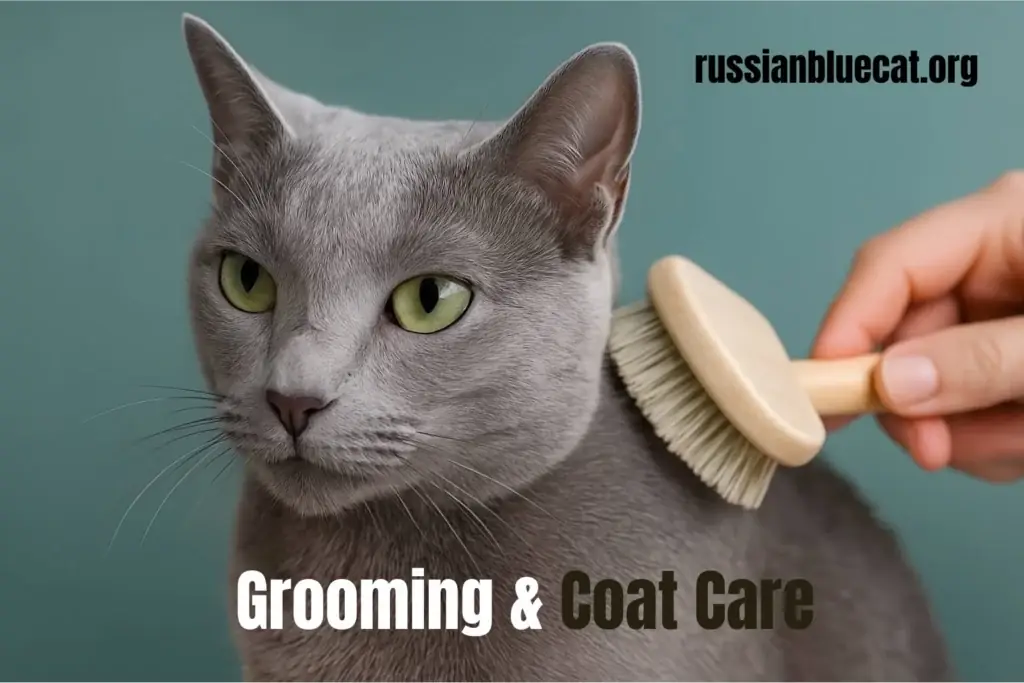Russian Blue Health The Ultimate Wellness Hub for Cat Owners

Introduction – Why Russian Blue Health is Important
When you initially bring a Russian Blue Cat into your home, you soon discover that they are so much more than a pet. With their radiant silver-blue fur, intelligent green eyes, and friendly nature, they diffuse tension and spread cheer into any household. But with their charm and beauty comes a duty: upholding Russian Blue health.
Unlike some other breeds which are more resistant to certain afflictions, Russian Blues do have special requirements. They’re bred to live long naturally, typically making it well into their teens, but only under the right conditions. This Russian Blue Health Guide written as part of our Russian Blue Cat Care at our website combines professional guidance, genuine owner stories, and veterinary commentary so you can make good decisions for your cat.
Understanding Russian Blue Health
A Naturally Hardy Breed
Russian Blues are one of the healthier pedigree cats. They have fewer genetic problems than some breeds, due to their fairly varied ancestry. “Healthy,” however, does not equal “invincible.” As with all cats, they require regular visits to a veterinarian, well-balanced diets, and careful attention to avoid issues before they become problems.
Why Russian Blue Cats Require Special Care
- Double thick coat: This is what keeps them warm but means they need to be brushed to avoid hairballs.
- Food love: Russian Blue Cats easily overeat, contributing to obesity and associated diseases.
- Easy-going temperament: Stress may impact their appetite and health. They do best in calm, stable households.
Russian Blue Cat Health Problems Common to Russian Blues
Hypertrophic Cardiomyopathy (HCM)
One of the most significant issues with Russian Blue health is HCM, a cardiac disease that results in thickening of the heart muscle.
Symptoms to look for: sudden collapse, labored breathing, lethargy, loss of appetite.
Prevention & care: Regular cardiac testing (echocardiogram, X-rays) is essential. The Cornell Feline Health Center says that the best method to deal with HCM is early detection. Medication can reduce symptoms and enhance quality of life.
Obesity & Diabetes
Russian Blues are voracious eaters and can easily become overweight. Obesity over time raises the risk of diabetes, arthritis, and heart stress.
Normal weight range: 7–12 pounds (but bone structure matters).
How to control:
- Employ measuring cups for accurate portion control.
- Don’t free-feed dry food.
- Provide high-protein, low-carbohydrate diets.
- Provide active play daily.
Dental Problems
Russian Blue Cats may suffer from dental problems such as gingivitis and periodontal disease if oral health is ignored.
- Brush 2–3 times per week with feline toothpaste.
- Have your vet schedule yearly dental checkups.
- Provide dental chews or toys that clean teeth naturally.
Urinary Tract Problems
A few Russian Blues are susceptible to urinary crystals or infections. These are painful and life-threatening if not caught early.
Prevention suggestions:
- Keep fresh, clean water available at all times.
- Utilize a cat fountain to stimulate drinking.
- Feed regularly with wet food to increase fluids.
- Watch litter box behavior very closely.
Nutrition & Feeding – Providing Russian Blue Wellness

What to Feed a Russian Blue Cat
Nutrition is the key to Russian Blue health. A well-balanced diet is needed to stay at a healthy weight and maintain long-term wellness.
- Protein sources: Select food with real chicken, turkey, or fish first on the ingredient list.
- Omega-3 fatty acids: Enhance coat condition and inhibit inflammation.
- Moderate carbs: Excess fillers (corn, wheat, soy) can contribute to weight gain.
- Hydration: Wet food prevents urinary issues through increased fluid consumption.
Feeding Schedule & Portion Control
- Kittens (1 year & under): 3–4 small meals per day.
- Adults (1–7 years): 2 measured meals a day.
- Seniors (7+ years): Small, frequent meals for simpler digestion.
Pro Tip: Employ slow-feeder bowls or puzzle feeders. These discourage overeating & introduce mental challenge.
Grooming & Hygiene for Healthy Russian Blues

Weekly Coat Maintenance
Even with their thick double coats, Russian Blues are very low-maintenance. Their coats do not mat easily but do shed more seasonally in spring and autumn.
- Brush every week, up to 2–3 times when they are shedding seasonally.
- Use a gentle bristle brush or grooming mitt to prevent pulling their coats.
- Brushing improves circulation and prevents hairballs.
Bathing Needs
- Russian Blues are naturally fastidious cats and only require the occasional bath.
- Bathe them only when absolutely necessary (e.g., after a mess).
- Use only shampoo safe for cats and towel-dry.
Nail, Ear & Eye Care
- Clip nails every 2–3 weeks.
- Inspect ears weekly for redness or wax.
- Carefully clean any eye discharge with a damp cloth.
Mental & Emotional Wellness
Personality and Stress Management
Russian Blues are shy but friendly. They form close attachments to one or two individuals and can be shy around strangers. Stress causes medical problems, so:
- Create a quiet hideaway area in your house.
- Maintain a routine for meal times and play times.
- Practice positive reinforcement to establish trust.
Exercise & Enrichment

- Interactive toys: Wand toys, feather teasers, and laser pointers.
- Vertical space: Cat trees or shelves to climb and investigate.
- Leash training: Most Russian Blue Cats love to take short walks outside if taught early.
Veterinary Care & Preventive Measures
Annual Checkups
Visit your Russian Blue with the vet for a complete physical check-up once annually. Post-10 years of age, visit bi-annually to monitor age-related complications early.
Vaccinations
- Core vaccines: Rabies, feline distemper (panleukopenia), calicivirus, and rhinotracheitis.
- Optional vaccines: Feline leukemia virus (FeLV), based on lifestyle.
Spaying & Neutering
Spaying or neutering enhances Russian Blue health by lessening the likelihood of reproductive cancers and stopping unwanted litters. It may also aid in behavior problems such as spraying.
Building a Healthy Home Environment

Safe & Comfortable Spaces
- Offer warm cat beds and quiet areas for resting.
- Clean their litter box and locate it in a low-stress zone.
- Introduce scratching posts to save furniture and encourage claw health.
Balanced Lifestyle
- Stick to established feeding schedules.
- Provide them with daily play to keep them from getting bored.
- Maintain low stress by not changing environment abruptly.
Russian Blue Health Hub Community
Russian Blue Health Hub Community

We think that health and happiness go together. That’s why we created the Russian Blue Care Hub, with this Russian Blue Health Guide among them, to serve cat enthusiasts everywhere.
This is how you can join our community:
- Go to our Contact Us page and ask us questions.
- Follow our WhatsApp Channel for daily tips, interesting facts, and adoption news related to Russian Blue health.
- Share your personal Russian Blue Cat experience to help others.
Interesting Russian Blue Cat Health Facts
- Russian Blues can live 15–20+ years with good care.
- They secrete less Fel d 1 protein, so they are better for allergy patients.
- Their double coat is not only beautiful but also aids in the regulation of body temperature.
- Most Russian Blues are left-pawed, a diminishing quality in cats.
- They’re also called the “aristocrats of the cat world” because of their elegant appearance.
FAQs Regarding Russian Blue Cat Health
Conclusion – A Lifetime of Wellness with Your Russian Blue
Maintaining Russian Blue health is not just about vet appointments or meal times it’s about creating a life of love, trust, and harmony. With their extended lifespan, your cat will be by your side for many happy years with the right nutrition, regular grooming, and routine veterinary care.
At the Russian Blue Care Hub, we want to be your go-to partner along the way. From grooming sessions to health tips, we’re here for you each step of the journey.
So whether you’re a new cat parent or a long-time fan of the breed, keep exploring our Russian Blue Health Hub. And don’t forget to connect with us via our Contact Us page or join our WhatsApp community for daily wellness tips.
